Successful radio programming is finding a balance between both effective short-term on-air content and smart long-term station branding, also in PPM markets.
It’s the key takeaway from a presentation by Warren Kurtzman of Coleman Insights who shared some dos & don’ts for program directors at Radiodays Europe 2012, based on their experience with PPM. Here’s why you may want to use Portable People Meter data only to analyze the effect of significant program events or major format changes and…
DON’T respond to non-significant events
When PPM was first rolled out in the USA, some program directors had a tendency to respond to less significant events. Examples are:
- a song that has been played
- a news story that has been broadcast
- a program feature that has been recently introduced
- a famous celebrity that calls into the morning show one time
- a television campaign to promote the station for a limited period of time
“That’s a short-term way of looking at PPM”, says Warren Kurtzman, president and COO of the media research company.
Focus on program events that continuously happen
over a long period of time
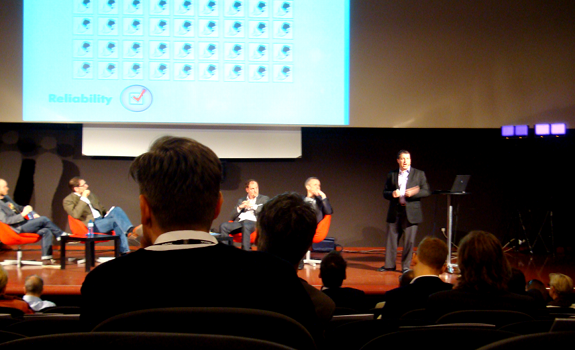
The panel with Dennis Christensen and Peter Niegel (DR), Arnaud Annebicque (Médiamétrie), the session host (name unknown) and Warren Kurtzman (Coleman Insights, standing) at Radiodays Europe 2012 (photo: Thomas Giger)
DO realize samples are limited
“When you’re looking at one moment in time, the number of Portable People Meters that the data is based on is pretty small.” He shows data from a couple of “fairly major radio stations” and in that graph we clearly see that on average, just a small number of meters is actually tuned in. It’s often just 3 or 4, with the highest numbers being 8 or 9! Going from 7 PPM-users to 5 – or from 7 to 9 – is indeed not significant enough to draw your conclusions upon.
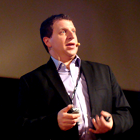 DO combine several different findings
DO combine several different findings
Another graph shows the market share of a station during 30 moments at which it aired a particular song. Surprise, surprise… sometimes the share (based on PPM-carriers) was a low as 0 when it played that song, on other times it was as high as a 17.9! Conclusion: “You can’t look at single events when you work with electronic audience measurement data, because the samples aren’t particularly robust at a given moment.”
DO conduct macro-level program analyses
A good thing to do, is macro-level content analysis. Focus on program events that continuously happen over a long period of time (like the Danish PPM research has taught us). “The advantage of aggregating data is that it improves the reliability”, Warren Kurtzman explains. “The drawback of it is that the data loses some immediacy; you need to look at things over an extended period of time.” In the case of 30 airplay moments of one and the same song on the same station, its average audience share was a 5.3 whenever they played it – “but even that is a pretty narrow thing to look at”.
Talk on a music station and transitions
may cause tune-out
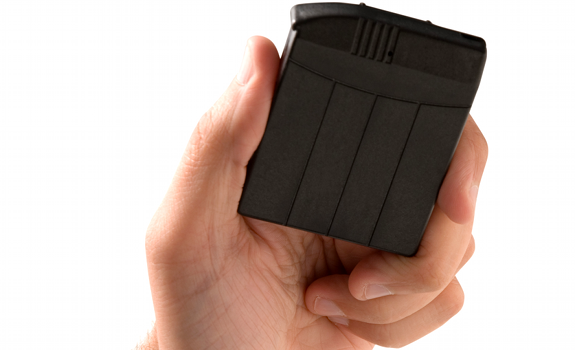
Portable People Meter ratings indicate more tune-out factors than tune-in reasons, and help program directors mainly to identify significant long-term trends – they’re not valid to evaluate individual short-term events (photo: Arbitron)
DO remind PPM reflects tune-out
The other thing that is important with macro-level content analysis is that “PPM is really good at showing what doesn’t work; it’s not very good at telling you what does work”. The Portable People Meter shows when you do something that listeners don’t like or when their lifestyle encourages them to don’t use the radio at that point in time. “There’s not a beacon or light that’s being sent out from your station that people can see from kilometers around and say: oh, they’re doing something really great, so I should tune in.” (Therefore it’s key to create listening instances – audience appointments for which radio could use social media!)
 DO focus on significant events
DO focus on significant events
“There’s a relationship between the significance of the event and your ability to actually decipher the impact of that event”. Kurtzman mentions a franchise contest: a major promotion that’s an integral part of the radio brand as it already runs for many years on the station. (I’m thinking of Z100’s Jingle Ball as an example.) Non-franchise contests, like a quick occasional price giveaway, are obviously less significant.
DO keep radio program flow
When PPM was just being introduced in the United States, program directors had to get used to deal with minute-by-minute performances of their radio station. They got the (basically correct) impression that listeners tune out for 2 main reasons:
1. Talk on a music station, like a jock talk, a news story or a stop set. (That makes sense, because (long) talk doesn’t meet the listener expectations of a music-driven format.)
2. Transitions from one sort of programming to another. It obviously happens when you suddenly play Classical music on an AC station, but also when you head from music into commercials.
“American radio stations sounded like a jukebox”
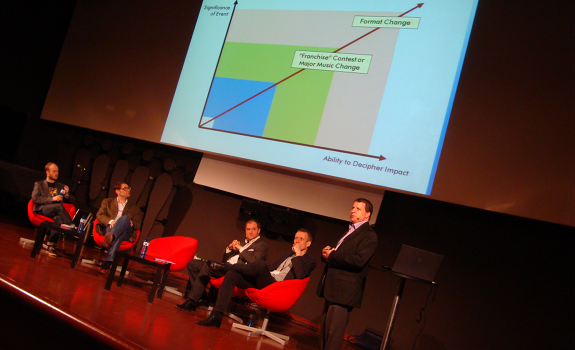
Warren Kurtzman of Coleman Insights (standing on the right) explains the relationship between the significance of an event and the ability to actually decipher its impact using Portable People Meter ratings (photo: Thomas Giger)
DON’T have ‘eliminating negatives’ mindset
American radio programmers initially installed 2 short-term solutions to avoid tune-out by simply identifying the negatives and eliminating them from the program as much as possible:
1. Music stations eliminated talk: they didn’t allow their on-air talents to speak much.
2. All stations disguised transitions: they didn’t want to audience to notice interruptions.
“American radio stations sounded like a jukebox a couple of years ago”, Warren Kurtzman recalls. They became extremely careful when it comes to transitions: “That includes even segueing songs one to another. They stopped doing things like production in between the songs – jingles and other things that would help to brand the station.” He thinks that the idea of eliminating all the negatives is not the best strategy.
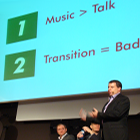 DO care about station branding
DO care about station branding
“Fortunately we eventually started to question this. We said: is this really what we want to do; be just that reactive to this new audience measurement system? The really good programmers recognized that their job is to manage both the content on the air and the overall brand of the radio station. It may seem obvious, but it really wasn’t being done there for a while. Everybody was so focused on the moment-by-moment execution of the content.”
DO envision current & future outcome
So while you’re “very conscious of the content on your station on a moment-by-moment basis”, you always keep in mind that “there’s another dimension and that’s the brand”. Of course everyone wants to focus on content that creates great short-term ratings and positive long-term branding (and avoid the opposite). Kurtzman righteously adds that the day-to-day job of most radio programmers is figuring out what to do in between. A common dilemma: some things might undermine your station’s ratings performance in the moment, but are great for building your brand over a longer period of time.
“Understand the relationship between
the moment-by-moment impact and the brand impact”
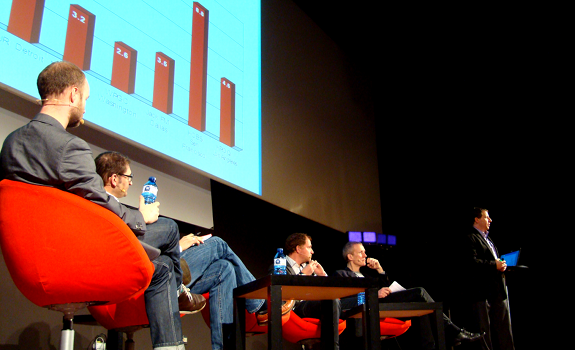
Warren Kurtzman points out that image-enhancing program features that cause some (P2 listener) tune-out could actually be loved by your P1 audience and boost both your ratings and brand in the long run (photo: Thomas Giger)
DO take strategic programming decisions
The minute-by-minute PPM data for a morning show revealed that a part of the audience tuned out whenever a certain feature started. “The non-strategic reaction to that is: let’s get rid of that feature. But it requires a little bit more investigation.” It was found that almost the entire core audience – P1 listeners, for which this station is their ‘Preference 1’ – kept listening to the feature. In other words: the audience loss was almost entirely concentrated among the second group, consisting of P2 listeners who had another ‘P1 station’ than this one.
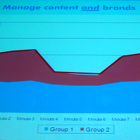 DO build P1 listener community
DO build P1 listener community
Additional research showed that this feature was actually very popular among listeners, and that if the feature was well known it would actually help grow the station’s brand and audience. “What will happen over time is that the dip will stay there, but the overall audience level will continue to rise“, Kurtzman knows from experience. “Understand the relationship between the moment-by-moment impact and the brand impact of what you do.”
Read also:
- Radio Listeners Behave Like Pavlov’s Dogs
- Program Director: Brand Manager & Talent Coach
- How To Program Radio Commercial Breaks Strategically
- Dennis Clark: “Jingles Are Part Of The Radio Brand”
- PPM: Radio Programming For Heavy Listeners
- Listener Expectations Influence Ratings
- Radio Promotions: The Naked Truth
Stay tuned, follow us @RadioILOVEIT and click below to share this post:





Hi Dave,
Thanks for reaching out, and for your kind words! I’m glad you enjoy the site and found inspiration here.
This is a great motivation, especially as you have such a long track record in radio. PD and Group PD for companies like (Southern Cross) Austereo, dmg Radio, and Prime Radio – overseeing brands like Triple M in Melbourne and Sydney’s Mix 106.5… hot markets, cool jobs!
And now 98 FM in Dublin – also a legend! I wish you a great time, and a successful stint. Please do let me know when there is any specific topic that you’d like to read more about. You can post it below, or email me through clicking on the ‘Email’ link in the sidebar on the right.
Thanks very much again!
Best regards,
Thomas
Hi,
I have recently moved from Australia to Dublin, Ireland to program 98 FM.
I stumbled across your website and just wanted to say how good it is. Plenty of great content and strong reminders of what we need to keep creating exciting and meaningful radio. After 20 odd years (very odd indeed!) it’s good to challenge the seriously depleted brain cells again.
Keep up the great work!
Cheers,
Dave